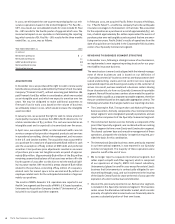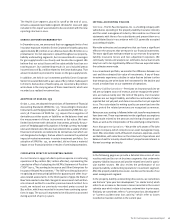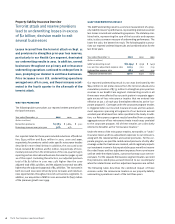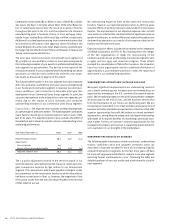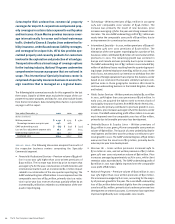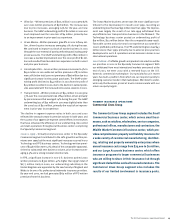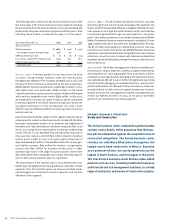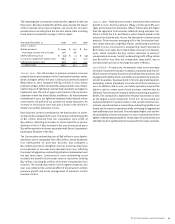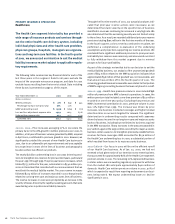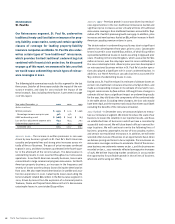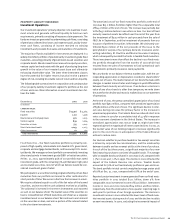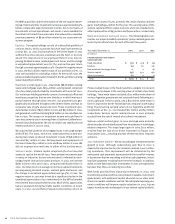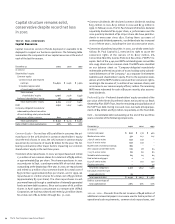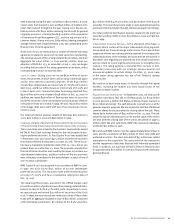Travelers 2001 Annual Report Download - page 28
Download and view the complete annual report
Please find page 28 of the 2001 Travelers annual report below. You can navigate through the pages in the report by either clicking on the pages listed below, or by using the keyword search tool below to find specific information within the annual report.
primary insurance operations
Health Care
The Health Care segment historically has provided a
wide range of insurance products and services through-
out the entire health care delivery system, including
individual physicians and other health care providers,
physician groups, hospitals, managed care organiza-
tions and long-term care facilities. In the fourth quarter
of 2001, we announced our intention to exit the medical
liability insurance market subject to applicable regula-
tory requirements.
The following table summarizes key financial data for each of the
last three years in this segment. Data for all years exclude the
impact of the corporate reinsurance program, and data for 2001
exclude losses resulting from the terrorist attack. Data including
these factors is presented on page 21 of this report.
Year ended December 31 2001 2000 1999
(Dollars in millions)
Written premiums $ 776 $ 659 $ 545
Percentage increase over prior year 18% 21%
GAAP underwriting result $ (979) $ (284) $ (70)
Loss and loss adjustment expense ratio 197.9 116.5 87.8
Underwriting expense ratio 23.3 25.7 27.0
Combined ratio 221.2 142.2 114.8
2001 vs. 2000 – Price increases averaging 27% in 2001 were the
primary factor in the 18% growth in written premiums over 2000. In
addition, a full year of business volume generated by MMI, acquired
in April 2000, contributed to premium growth in 2001. However, we
significantly curtailed the amount of new Health Care business in
2001, due to an unfavorable pricing environment and unacceptable
loss experience in most of the lines of business and geographic
locations where we offered our products.
The nearly $1 billion underwriting loss in 2001 was driven by provi-
sions to strengthen loss reserves for prior accident years, particularly
the years 1997 through 1999. The prior-year reserve increases, which
totaled $735 million for the year, culminated in a $540 million pro-
vision in December that coincided with our announcement that we
would exit the medical liability market. The 2001 reserve increases
followed $225 million of increases recorded in 2000 that primarily
related to our long-term care and major accounts lines of business.
The reserve increases in 2000 were prompted by an increase in the
severity of losses driven by the rapidly escalating amounts that were
awarded by juries in professional liability lawsuits.
Through the first nine months of 2001, our actuarial analyses indi-
cated that prior-year reserve actions were necessary, as we
determined that claim severity on the specific lines of business
identified in 2000 was continuing to increase at a very high rate. We
also determined that the worsening severity was not limited solely
to those lines. As a result, we recorded additional prior-year reserve
provisions totaling $195 million in the first nine months of the year.
In the fourth quarter, as loss severity continued to escalate, we
performed a comprehensive re-evaluation of the underlying
assumptions and projections supporting our reserve positions. We
concluded that a significant additional provision to prior-year med-
ical liability loss reserves was necessary, and announced our intent
to fully withdraw from this market segment due to minimal
prospects for future profitability.
As part of the strategic review that led to our decision to exit the
medical liability business, our analysis of the unamortized goodwill
asset of $64 million related to the MMI acquisition indicated that
approximately $56 million of that goodwill was not recoverable, and
that amount was written off in the fourth quarter of 2001. The
remaining goodwill deemed recoverable was related to that portion
of MMI’s ongoing consulting business that was not placed in runoff.
2000 vs. 1999 – Health Care premium volume in 2000 included $98
million of premiums from MMI’s domestic operations. In 1999, the
written premium total included a one-time premium of $37 million
recorded on one three-year policy. Excluding that premium and
MMI’s incremental contribution in 2000, premium volume in 2000
was 11% higher than 1999. The increase was driven by price
increases, new business in selected coverages and higher renewal
retention ratios on accounts targeted for renewal. The significant
deterioration in underwriting results compared with 1999 was
driven by losses incurred in our long-term care and major accounts
books of business, including but not limited to business acquired
in the MMI transaction. Sharp increases in the amounts awarded in
jury verdicts against the large entities served by the major accounts
business center caused us to strengthen previously established loss
reserves for these coverages. MMI accounted for $256 million of
the Health Care underwriting loss in 2000, a substantial portion of
which resulted from losses in its major accounts business.
2002 Outlook – Our focus in 2002 will be on the efficient runoff
of our Health Care business. As of Jan. 23, 2002, we had not
renewed or had given notice of our intention not to renew business
that accounted for approximately 80% of the Health Care segment’s
premium volume in 2001. The remaining 20% represented business
in states where we are awaiting regulatory approval to withdraw
from the market. We anticipate approximately $400 million of
domestic Health Care written premium volume in 2002, 50% of
which is expected to result from reporting endorsements on busi-
ness being exited. We expect underwriting losses to decline
significantly in 2002.
The St. Paul Companies 2001 Annual Report26


